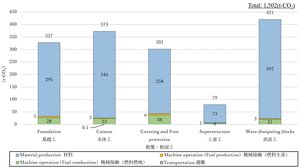Major Research Proposal of Green Transformation (GX) strategy for port structures to achieve carbon neutrality
With the trend toward global decarbonization gathering pace, efforts are underway to achieve Carbon Neutral Port (CNP) in the Japanese port sector. Thus, it is becoming increasingly important to minimize CO2 generation in terms of the construction of port structures. To efficiently facilitate this process of CO2 emission mitigation, it is crucial to first quantify and understand the characteristics of the CO2 emissions that occur during port structure construction, and then explore effective ways to achieve the carbon mitigation goals. However, there is still not enough research on the amounts of CO2 emissions that occur when port structures are built. In this research project, we organized information on CO2 emission computation methods and quantified the amount of CO2 emissions that typically arise in a project to build a breakwater covered with wave-dissipating concrete blocks. Our calculations revealed that nearly 90% of the CO2 emissions caused in such a project mainly arose from the material manufacturing activities, of which roughly
70% was attributable to concrete. It was also discovered that the majority of the CO2 emissions that resulted from machine operations was from the work vessels, as the machines being operated
on land produced less CO2. Having clarified the CO2 emission characteristics, we could determine the direction of our technological development to achieve each of the defined reduction goals, etc. Furthermore, after carefully investigating the concrete that was responsible for the majority of CO2 emissions, we found that the total CO2 emissions that occurred in each construction project could be reduced by 30-45% simply by switching to the optimal cement type (regular, blast furnace type B, or blast furnace type C). This confirmed the effectiveness of switching to low-carbon materials where possible and the necessity of developing low-carbon materials that can be applied to and withstand the marine environment that surrounds port structures. Regarding our initiative to develop low-carbon materials, we are continuously conducting basic research on carbon fixation methods that utilize CO2 nano-bubble water and dredged soil to verify their efficacy and identify any potential issues

CO2 emissions from the construction of breakwaters covered with wave-dissipating concrete blocks



